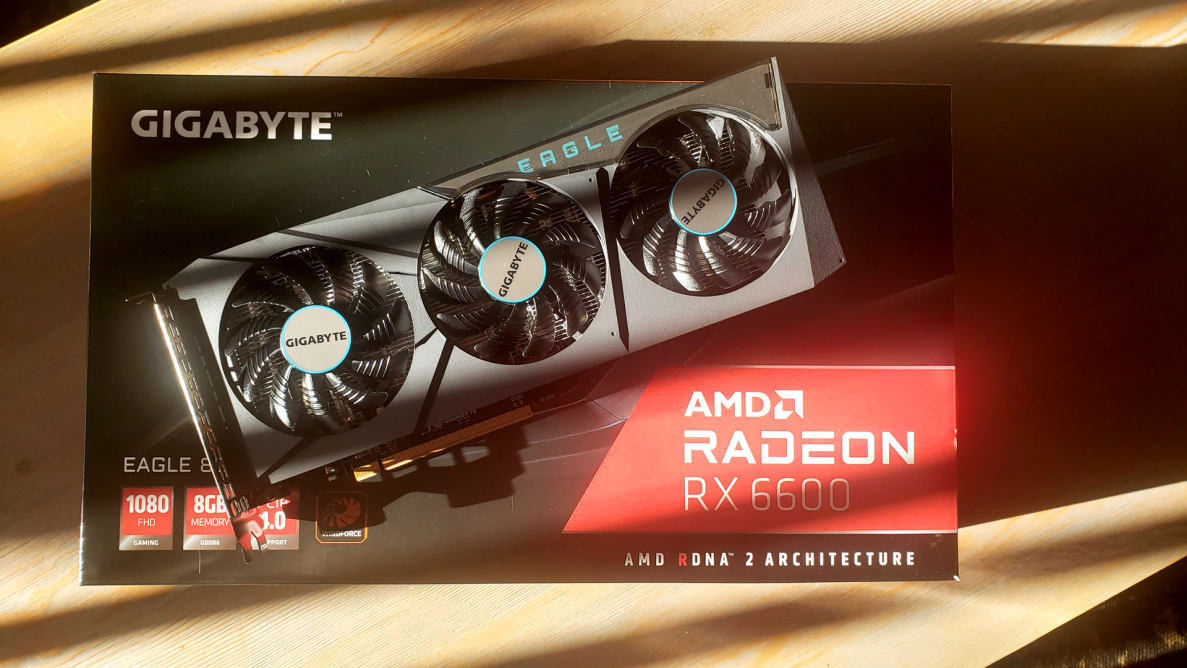Pros
-
Great 1080p performance
-
Good overall value
Cons
-
Poor ray tracing
-
Upscaling tech is so-so
About the AMD Radeon RX 6600 (Gigabyte Eagle 8GB)
Here are the specs of the graphics card we tested:
- Compute units: 28
- Base frequency: 1626MHz
- Boost frequency: Up to 2491MHz
- Game frequency: Up to 2044MHz
- Ray Accelerators: 28
- Stream Processors: 1792
- Power requirement: 132W
- Infinity Cache: 32MB
- Memory Speed: 1750MHz
- Max Memory Size: 8GB
- Memory Type: GDDR6
- Memory Interface: 128-bit
- Memory Bandwidth: Up to 224GB/s
There isn’t a massive difference in specs between the RX 6600 and its more powerful sibling, the RX 6600 XT ($379 MSRP). AMD shaved off four compute units, reduced the memory bandwidth, lowered the GPU clocks, and tweaked the card in a few other ways so the RX 6600’s performance makes sense at its $329 price point.
For our GPU testing, we used the following desktop PC configuration:
- Processor: AMD Ryzen 9 5950X
- Motherboard: Asus ROG Maximus Extreme XII X570
- Memory: G.Skill Trident Z Royal 16 GB (2 x 8 GB) DDR4-3600 MHz
- Storage: Samsung 970 NVMe M.2 500GB SSD
- Power: Seasonic Focus GX-1000
- Cooling: Corsair H150i Pro RGB
The AMD Ryzen 9 5950X is a standard part of our test bench, but you can pair the RX 6600 with a Ryzen 5 5600 processor and still get the same level of gaming performance. (Not to mention the Ryzen 5 5600 is the more affordable option.)
What we like
It handles most games at 1080p like a champ
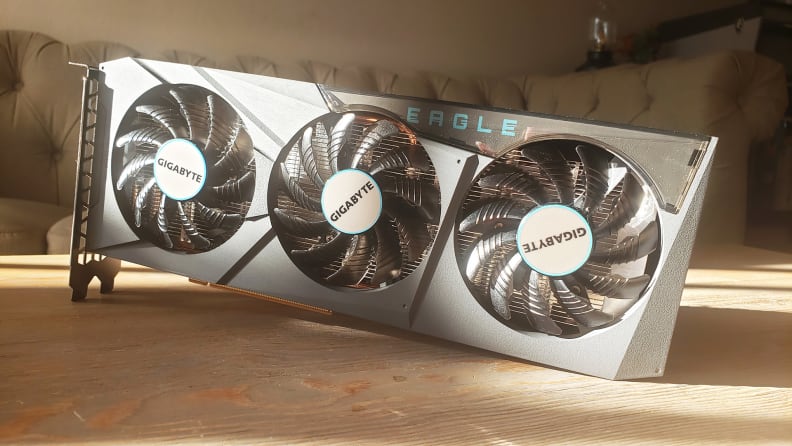
AMD's Radeon RX 6600 is a much better value than its slightly more powerful sibling, the RX 6600 XT.
AMD’s Radeon RX 6600’s $329 MSRP is the same as Nvidia’s very capable RTX 3060. That most likely won’t mean much in the current GPU marketplace (thanks, scalpers), but it’s still important to look at pricing since the RX 6600 is a close equivalent to the RTX 3060 performance-wise.
We tested a total of 12 games at three resolutions (1080p, 1440p, and 4K), four of which are ray tracing compatible. Because of this GPU’s specs, it’s designed for gaming at 1080p, though it gets decent 1440p performance in some games. It doesn't perform as well at that resolution as the step-up Radeon RX 6600 XT, but it holds its own. 1080p is where the RX 6600 shines like the Griswolds' house during the holidays. (Just make sure it’s plugged in.)
What you get for an assumed $329 price tag is mid-range performance, including an average of 94 frames per second across all 12 games with the resolution set to 1080p and the graphics preset turned to the highest level possible. (We did some testing with AMD’s framerate boosting tech, FidelityFX Super Resolution, but more on that later.)
Games like Far Cry 5, and Shadow of the Tomb Raider, get more than 100 fps with the RX 6600, while more demanding games like Total War: Warhammer II, Division 2, and Assassians Creed Odyssey topped out around 70 fps.
The RX 6600 even fared well against the high demands of Metro Exodus, Control, and Cyberpunk 2077, netting between 48 and 71 fps. Control earned the highest marks in this part of our testing, but Metro and Cyberpunk still ran smoothly even though they could not reach over 60 fps at 1080p.
By comparison, the RTX 3060 gets an average of 102 fps across the same games. With ray tracing turned on the RX 6600 averages around 10-15 fewer frames than the RTX 3060 at 1080p. Its performance is only a few frames behind AMD’s RX 6600 XT ($379 MSRP)—not enough to make a difference to a casual observer, however.
It’s ray tracing where the RX 6600 falters, especially compared to Nvidia's RTX 3060. While the GPU can output 30 frames or more in Control and Metro Exodus, movement is sluggish and you will frequently miss shots as the GPU tries to play catch up with your reflexes. To get any noteworthy ray tracing performance out of a current-gen AMD graphics card with demanding games, you’ll need at least a Radeon RX 6800 XT—or play less demanding games like Myst. That game looks nice with ray tracing turned on, albeit the changes are subtle.
That said, if you mostly play first-person-shooters, racing games, or anything else that requires quick reflexes, the RX 6600’s relatively high frame rates pair nicely with a high refresh-rate monitor, especially ones at 165Hz and above. You will need to turn down the graphics settings from Ultra to High (or lower) in a game like Overwatch so you can get as close to hitting your monitor’s maximum refresh rate as possible, but you probably don’t need pristine graphics for an esports game anyway.
Low power consumption
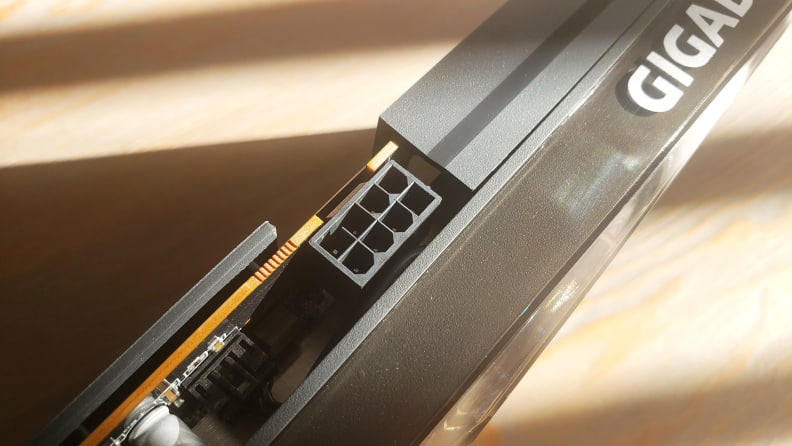
The Radeon RX 6600 is a low-wattage graphics card, which means you don't need to buy a massive power supply unit.
This might not be something most people outside of desktop PC builders think about, but the RX 6600’s low power consumption is a nice perk for any GPU to have. Lower power needs mean you might save some money on a power supply unit by picking something with lower wattage, and it also means your electricity bill will be slightly cheaper, too. (It might not be much, but hey, money is money.) Most importantly, the amount of power a GPU consumes is an indication of how efficiently it runs.
The Radeon RX 5700, which is one of AMD’s last-gen GPUs, requires 180W of power. The more efficient RX 6600 only needs 132W. While we don’t recommend upgrading to an RX 6600 just for the lower power consumption, we like seeing less wattage.
What we don’t like
If you don't care about ray tracing, you can skip this card
The RX 6600’s performance is near-identical to AMD’s older RX 5700. Sure, the RX 5700 doesn’t have ray tracing and it’s built on older chip architecture, but considering the RX 6600's lower-quality ray tracing, it isn't as big of a step forward over the RX 5700 as we'd hoped for. If you’re on a budget and don’t care about ray tracing, the 5700 is a solid alternative.
However, the market is insane right now, and RX 5700 prices are still well above their original $350 MSRP.
You could try your luck with an RTX 3060, which has slightly better performance than the RX 5700 and RX 6600, but the pricing for that card averages between $500 and $850, while the RX 6600 can be found on eBay (at publication time) at around $500 to $650. This is the market we're dealing with right now, unfortunately.
FidelityFX Super Resolution is a hit and miss
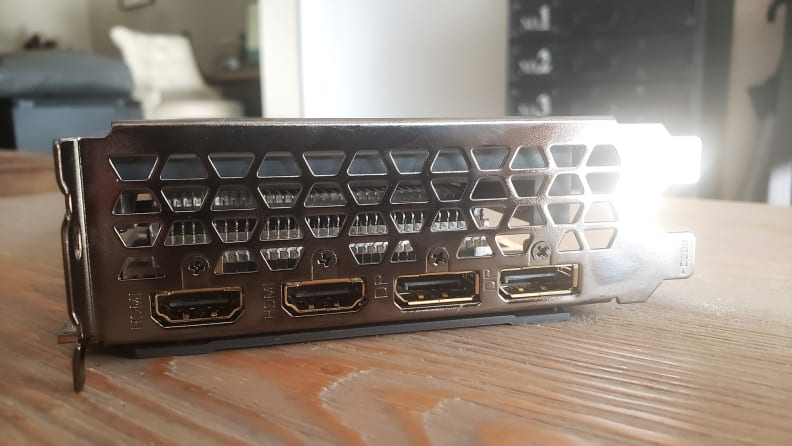
This RX 6600 has two HDMI and two DisplayPort connections.
FidelityFX Super Resolution (FSR) is AMD’s response to Nvidia’s DLSS; both technologies use AI to upscale a game’s resolution, which reduces the computing load on the graphics card so the game can reach a higher frame rate. For GPUs like the RX 6600, this is a neat feature to have if you’re trying to reach 60 fps in a graphically demanding game like Metro Exodus or Cyberpunk 2077 without turning down the graphics preset.
We looked at a few games that support both DLSS and FSR, using the RX 6600 and Nvidia’s RTX 3060, and both GPUs are capable of hitting around the same number of frames with those features turned on. The Medium, for example, averaged 109 fps at 1080p with FSR set to Ultra Quality with the RX 6600, while the RTX 3060 output 111 fps at 1080p with DLSS set to Nvidia’s essential equivalent, Quality.
However, Nvidia’s upscaling technology looks better, especially when DLSS is set to Performance mode. In The Medium there’s a bedroom you can walk into at the start of the game with translucent red curtains over the windows. You can see the faint lines of the windowpane through the curtain, but those lines flicker rapidly when AMD’s FSR is set to Performance mode. Nvidia’s DLSS also causes the same effect when set to Performance mode, but the flickering is much more subtle; the windowpane lines look almost still.
The same thing happened during the opening scene of Resident Evil Village; the dining room lights cast a flickering shadow over the baby’s high chair, but again AMD’s FSR made the flickering worse in Performance mode compared to Nvidia’s DLSS.
Clearly, AMD FSR works, and you can get a major frame rate boost with it enabled (from 91 fps to 130 fps in Far Cry 6, for instance), but that brings up another issue: game compatibility. Game developers have to build in support for that kind of upscaling.
Nvidia has the largest library of DLSS-supported games currently, while AMD’s FSR doesn’t currently work with many of those same games. That includes titles like Metro Exodus, Cyberpunk 2077, and Control, even though AMD’s ray tracing is supported. Those graphically demanding games are the kind that benefits the most from upscaling technology, while esports games generally get high frame rates even with lower-end graphics cards.
Should you buy it?
Yes, if you can find it for close to its MSRP
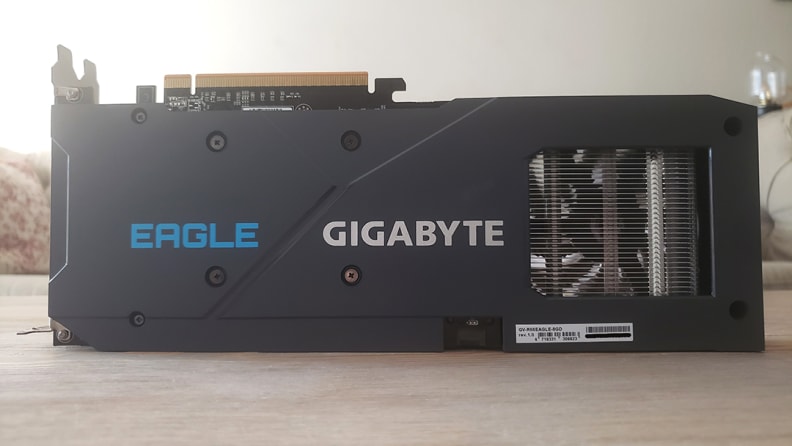
We're not crazy about the exposed heat sink on the back of the card, but the GPU will be in your PC case, so you won't have to look at it.
One of our biggest complaints about the RX 6600 XT was that it wasn’t the best performance for your money. Now that the RX 6600 is here, AMD has a much better alternative to both Nvidia’s RTX 3060 and its own, albeit older, RX 5700. If you skipped AMD’s Radeon RX 5000 generation, the RX 6600 would be an excellent upgrade, especially if you’re not looking to build a super fancy PC. It cranks out stellar framerates, even in demanding games like Cyberpunk 2077.
If you want ray tracing for those kinds of games though, you may want to look elsewhere. The RX 6600’s frame rates with ray tracing on are low, even at 1080p. You can turn the graphics preset down or disable specific ray tracing effects if the game allows, but it won’t look as nice. However, for far less demanding games like Myst, the RX 6600's ray tracing works great.
If you’re new to PC gaming or on a tight budget, AMD’s Radeon RX 6600 is a great GPU. Combined with AMD’s special hardware and software features for boosting frame rates, there’s a lot you’ll be able to get out of this graphics card for years to come.
Meet the tester
Joanna specializes in anything and everything gaming-related and loves nerding out over graphics cards, processors, and chip architecture. Previously she was a staff writer for Gizmodo, PC Gamer, and Maximum PC.
Checking our work.
Our team is here to help you buy the best stuff and love what you own. Our writers, editors, and experts obsess over the products we cover to make sure you're confident and satisfied. Have a different opinion about something we recommend? Email us and we'll compare notes.
Shoot us an email